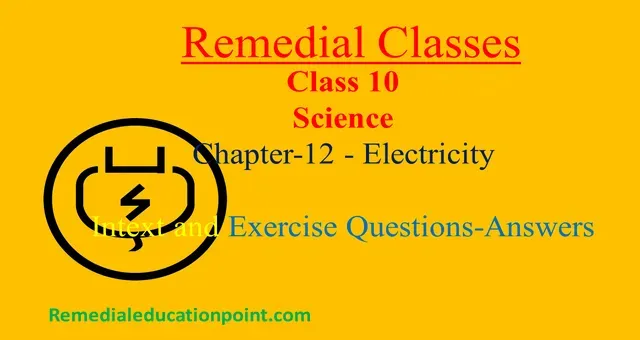In this post, you will get NCERT Class 10 Science Chapter 12 Exercise SolutionsWhich covers all topics in the NCERT Science book of class 10 and let you secure the best results in CBSE and other board exams. NCERT Class 10 Science Chapter 12 Exercise Solutions will help you to solve homework and home assignments in an easy way.

NCERT Class 10 Science Chapter 12 Exercise Solutions
You must know the topics and subtopics before you go through NCERT Class 10 Science Ch 12 Solutions for Class 10.
1. Electric Current
and Circuit
2. Electric charge
3. Types of charges
4. Coulomb’s law
5. How does a body
acquire charge?
6. Conduction and
insulators
7. Type of electricity
8. Concept of Drift
speed
9. Electric Potential
and Potential Difference
10. Circuit Diagram
11. Ohm’s Law
12. Factors on Which
the Resistance of a Conductor Depends
13. Resistance of A
System of Resistors
14. Heating Effect of
Electric Current
15. Superconductivity
16. Combination of
resistance
17. Benefits of the series combination
NCERT Solutions for Class 10 Science Chapter 12 are based on the latest syllabus of CBSE 2021-22.
Solutions of Chapter12 Electricity of NCERT Science
for Class 10 Intext questions
Chapter 12 Electricity
Class 10 Science Chapter 12 Intext Questions
The important point of Chapter 12 Science Class 10
1. A
stream of electrons moving through a conductor constitutes an electric current.
Conventionally the direction of current is taken opposite to the direction of the flow of electrons.
2. The
SI unit of electric current is Ampere.
3. To
set the electrons in motion in an electric circuit. We use a cell or a battery. A
cell generates a potential difference across its terminals. It is measured in
Volts.
4. Resistance
is a property that resists the flow of electrons in a conductor.it controls the
magnitude of the current. The SI unit of resistance is the ohm.
5. Ohm’s
law: The potential difference across the ends of a resistor is directly
proportional to the current through it, provided its temperature remains the same.
6. The
resistance of a conductor depends directly on its length, inversely on its area
of cross-section, and also on the material of the conductor.
7. The
equivalent resistance of several resistors in a series is equal to the sum of their
individual resistances.
8. The
electrical energy dissipated in a resistor is given by W= V × I × t
9. The
unit of power is Watt, one watt of power is consumed when 1A of current flows
at a potential difference of IV.
10. The
commercial unit of electrical energy is a kilowatt-hour (kWh).
11. Electrical
current is measured by an instrument called Ammeter. Ammeter is always connected
in series in an electrical circuit.
12. Potential
difference is measured by an instrument called a voltmeter. A voltmeter is always
connected in parallel in an electric circuit.
13. Electric
fuse: is a safety device which works on the principle of heating effect of
electric current and it protects the electrical appliances from being damaged.
Related Topic -
If you find any difficulty, please do comment.
Hoping for progress with Remedial Classes
Frequently Asked Questions
1. What is Ohm's law answer?
The potential difference across
the ends of a resistor is directly proportional to the current through it,
provided its temperature, length, and area of cross-section and material remain
the same.
2. What is meant by the resistance
of a conductor?
Resistance is the basic property
of any material. Resistance is the property that resists the flow of electrons
in a conductor. It controls the magnitude of the current.
3. What is the cause of resistance
of a conductor Class 10?
In class 10 12th
chapter is electricity. A conductor has free electrons or ions in it that are the
main cause of resistance, these free ions resist the flow of current in a
conductor.
4. What is ohm's law explain class
10th?
The potential difference across
the ends of a resistor is directly proportional to the current through it,
provided its temperature, length, and area of cross-section and material remain
the same.
5. What is the electricity definition
for class 10?
A stream of electrons moving
through a conductor constitutes an electric current. The rate of flow of charge is
defined as electric current. SI unit of electric current is ampere.




No comments:
Post a Comment